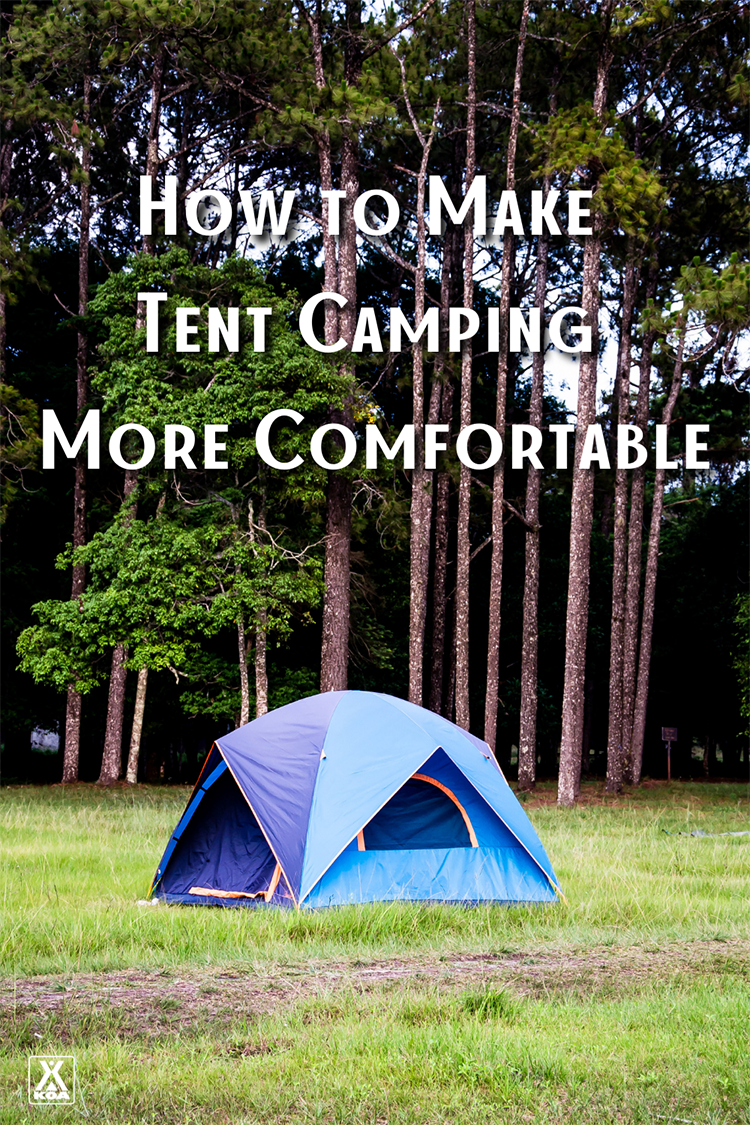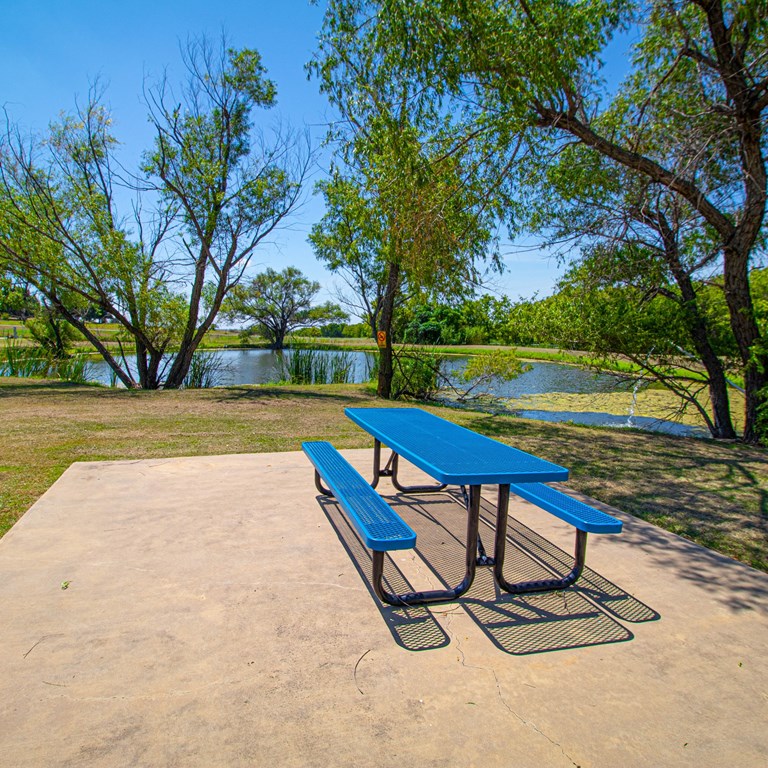HOW TO MAKE TENT CAMPING MORE COMFORTABLE

TIPS FOR MAKING TENT CAMPING MORE COMFORTABLE
Nearly 60% of campers use a tent because they provide a more primitive experience compared to RV and cabin camping and allow you to wake up and fall asleep to the sounds of nature surrounding you. Tents make it easier than ever to bond with your friends and family, and nothing feels quite as satisfying as sleeping in a structure you assembled on your own. There are also several ways you can make your tent even cozier and get a comfortable night’s sleep.
GET THE RIGHT TENT SIZE
One of the most important decisions you can make is your tent’s type and size. By choosing a tent that provides plenty of space for each camper and your luggage — but without so much excess space that the tent is drafty or cumbersome to carry — you are setting yourself up for a successful camping trip right from the start.
There are several different types of tents, including:
- Cabin tents: Cabin tents look like polyester and nylon cabins, with multiple rooms and windows. They provide ample space to move around.
- Dome tents: Dome tents are lightweight, which makes them easy to set-up and tear down. Dome tents tend to be less stable the larger they are, so they are best suited for two to four sleepers.
- A-frame tents: A-frame tents, also known as wedged tents or ridge tents, are sturdy and stable, thanks to the support beam and poles at the top and sides. They usually have less headroom than cabin and dome tents.
- Pop-up tents: Pop-up tents do not require the same set-up that others do, and they tend to be some of the most common tents for camping.
Choose the size of your tent based on the number of campers you typically bring along on your outdoor getaways. Single room tents — like a dome or A-frame tent — usually sleep two to four people comfortably, while multi-room tents — including cabin-style tents —are ideal for large groups of people, like families, who require more space and privacy.
CHOOSE THE RIGHT BEDDING
Comfortable tent bedding is the key to having a good night’s sleep on your camping trip. This includes choosing the right sleeping bag, blankets and pillows, as well as adding an air mattress or sleeping pad when necessary.
SLEEPING BAGS
While it is fine to have a few blankets around your tent for cozying up by the fire or early-morning breakfasts, you also need a sleeping bag. A sleeping bag is designed to keep you warm by trapping your body heat inside. Choose your sleeping bag based on its:
- Shape: Mummy sleeping bags are built more narrowly in the shoulder and hip area to reduce the amount of material used, which makes the bag lighter. The cut of these sleeping bags also helps you stay warmer at night. Rectangle sleeping bags are the typical sleeping bag shape and the one that offers the most comfort. With more room than other sleeping bags, you will not feel constrained in your rectangular sleeping bag. Even better is that you can hook together two of these bags. Get one bag with a right-hand zipper, and one with a left-hand zipper to make a nice big bed. You can also choose a double sleeping bag if you want to sleep alongside someone else.
- Insulation: Make sure you choose a high-quality sleeping bag that is insulated, especially if you are going camping in the fall or winter. Sleeping bags are insulated with either goose down or synthetic filling.
- Size: Many sleeping bags are a standard size, but you can also find men’s and women’s long and regular length bags at camping stores.
AIR MATTRESSES AND SLEEPING PADS
While not mandatory, an air mattress, sleeping pad or camping cot provides the most comfortable way to sleep in a tent. They put a barrier between you and the hard ground and give you a softer surface to lay your sleeping bag on. They can also add extra insulation to keep you warmer at night. Here are some of the differences between them:
- Sleeping pad: Sleeping pads add a layer of cushioning between your body and the tent’s floor. Because many roll up and fit inside your backpack or luggage, they are easy to bring along. Closed-cell sleeping pads are sturdy and insulating. Air pads are inflatable and comfortable but do make noise when you roll around on them. Self-inflating sleeping pads provide the structure and insulation of a closed-cell sleeping pad.
- Inflatable air mattresses: Inflatable air mattresses are a great choice for many campers because they offer supreme comfort compared to a sleeping pad. They are similar to regular beds — you can choose between single, double, queen and king sizes, and you can even find some with features like a cushioned pillow top. Inflatable mattresses do require an air pump, though.
- Camping cots: A camping cot is similar to a regular bed because it consists of a lightweight frame that holds a thin, cushioned sleeping pad above the ground. They operate similarly to your bed at home, meaning you can sit on it, store things underneath and not worry about the ground below.
BLANKETS AND PILLOWS
Because adjusting to a new pillow — especially when in a brand new sleeping environment — can take time, it is a good idea to bring your pillows from home to help your sleeping routine feel as normal as possible. That said, you probably do not want to bring the blankets from your bed. Camping blankets are made with special materials to keep you warm during cold nights and are typically more durable than standard blankets. Common camping blanket materials include those made of fleece and wool, as well as thermal, folding, zipped and convertible options. Choose your camping blankets based on the season and type of environment you are camping in.
HOW TO MAKE TENT CAMPING MORE COMFORTABLE: OPTIONAL GEAR AND EQUIPMENT
To learn more about how to make tent camping comfortable, consider investing in a few optional tools, such as:
- A battery-operated fan to keep you cool and drown out sounds from other campers
- A tent-safe heater and tent ventilation if you are winter camping
- Foam floor tiles or yoga mats to create more padding between you and the ground
- A hot water bottle to slip inside your sleeping bag during low temperatures
- A sound or white noise machine or earplugs to help you fall asleep easier
TIPS FOR MAKING TENT CAMPING MORE COMFORTABLE
Once you have chosen the right type and size of the tent and stocked it with outdoor-safe bedding and equipment, there are a few more things you can do to make your experience even more comfortable:
- Keep your clothes in the car: Despite your best efforts, the air inside your tent can sometimes get a little moist or humid, which can infiltrate your luggage and make your clothes damp. To combat this, keep the suitcase with your clothes inside your vehicle and take out your outfit each morning.
- Do not forget a flashlight: As a tent camper, you will rely on your flashlight for a lot — navigating the campsite, moving around your tent at night and walking to and from the bathroom after dark. Bring at least one high-quality flashlight with backup batteries.
- Add waterproofing: There are a few ways you can improve your tent’s ability to repel water, like spraying a waterproofing solution, sealing the seams or hanging a tarp above the roof. To keep your tent dry, always patch holes or tears as soon when you find them and keep your tent walls clean.
- Store food outside: Food can attract bugs and wildlife, so keep it far away from your tent. Try storing your food and all kitchen supplies in a secured cooler, bear-proof container or your vehicle.
- Dress for bed: If you are camping in cooler weather, something as simple as wearing socks to bed can make a huge difference to your comfort through the night. When camping during hot weather, choosing lightweight materials is key to staying cool.
- Bring an outdoor mat: Bring an outdoor rug for the outside of your tent to avoid tracking in mud, sticks and dirt.
- Put some slip-on shoes nearby: In case you need to get up in the middle of the night for a bathroom run, put some shoes next to you, so it is easier for you to make that trip.
TENT CAMPING AT KAMPGROUNDS OF AMERICA
One of the best decisions you can make about tent camping is choosing a campground that offers level, spacious and clean Tent Sites to make set-up and sleeping easy and comfortable. You can expect these benefits at every KOA Tent Site. You will also have a private fire feature and easy access to restrooms and hot showers.
At some KOA locations, you will find Premium Tent Sites, which are even more spacious with additional parking and electric hookups. Some campgrounds also offer fun on-site amenities and activities like pools, movie nights or rock climbing.
Tent camping is a memorable experience and a great way to connect with nature and loved ones. With these tips in hand, you are ready to enjoy your entire tent camping experience — including a restful night of sleep. Reserve your Tent Site today.

